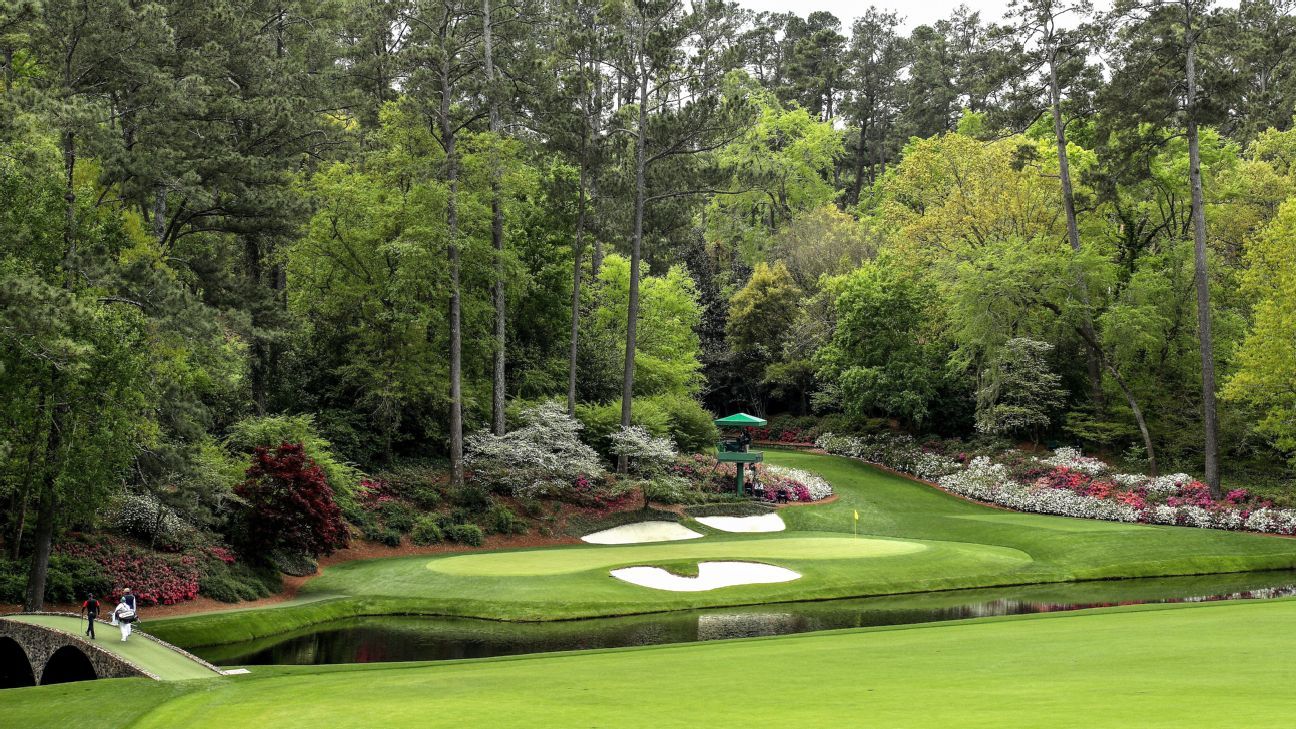Editor’s note: This was originally published on April 4, 2019. All statistics have been updated to reflect action from the 2019 Masters Tournament, won by Tiger Woods.
This week, as they are every spring, the visuals from Augusta National and the Masters would have been everywhere.
Amen Corner. Magnolia Lane. Azaleas and dogwoods. Green jackets.
But the coronavirus pandemic that has halted the world, and shut down sports, forced the postponement of the 2020 Masters in Augusta, Georgia.
It doesn’t mean we can’t, in our mind’s eye, still wander the fairways, peer across Hogan’s Bridge, remember the place’s beauty and its difficulty and wait for the day when the gates open and Jack Nicklaus and Gary Player slap the ceremonial first tee shots down the opening fairway.
How to watch classic Masters coverage this week on ESPN
So, with the help of some former Masters champions, we offer the ultimate hole-by-hole look at Augusta National:
Jump to a hole:
No. 1 | No. 2 | No. 3 | No. 4
No. 5 | No. 6 | No. 7 | No. 8
No. 9 | No. 10 | No. 11 | No. 12
No. 13 | No. 14 | No. 15 | No. 16 | No. 17 | No. 18
-
Secrets from past Masters champions, as told to Michael Collins
-
History of each hole compiled by ESPN Stats & Information
-
Cheat sheet: In order, three hardest holes: No. 10, No. 11, No. 4; Three easiest holes: No. 15, No. 13, No. 2
No. 1: Par 4, 445 Yards
The fine folks at Augusta National do not allow a player to ease into their Masters experience. Just what you want at the start, with your nerves still jangling after your name is announced — a narrow tee shot with trouble right and left. The first hole played no worse than fifth hardest in last year’s Masters, and it actually was the hardest hole on the golf course in the third round in 2018. Goal: Make par, deep breath, move on.
 Tiger Woods’ secret to No. 1
Tiger Woods’ secret to No. 1
“If [the wind] is not blowing, it’s not that hard a hole. It’s a 3-wood if they move the tee up or it’s a cut-driver down there. When the wind is blowing, though, if it’s coming out of the west or the north, that is one the hardest opening holes, because that green is not designed for a 6-iron or a 5-iron. It gets scary. … If you are able to play the hole in 16 [total strokes] you’ve picked up quite a lot on the field.”
Changes to ‘Tea Olive’
• 2002: Tees moved back 20 to 25 yards. Fairway bunker reshaped and extended 10 to 15 yards toward the green. Portion of fairway landing area regraded.
• 2006: Tees moved back 15 to 20 yards. Trees added to the left side of the fairway.
• 2008: Ten yards added to front of the tees. Back of tees reduced to ease patron movement.
• 2009: Back of tee reduced 8 yards. Tee marker relocated and Masters scorecard changed to 445 yards.
• 2010: Practice putting green behind first tee reduced by 20 percent to improve patron flow.

No. 2: Par 5, 575 Yards
There were 83 bogeys or worse on the first hole at last year’s Masters. No. 2 is the chance to make up for it. It is never played at even par or worse; the highest average score for the week was 4.996 in 1957. On Sunday, when the hole is cut back right, watch shots funnel down the hill toward the pin and give those in pursuit of the lead a chance at both an early eagle and the first roars of the day from the patrons. What is not as noticeable on No. 2? Just how much of an elevation drop (first hill reference!) it is from the second shot all the way to the green.
 Zach Johnson’s secret to No. 2
Zach Johnson’s secret to No. 2
“They key at No. 2 is just getting your drive in play, because you can make a [birdie] or [eagle] from the fairway. If there’s another key, it’s to miss, for the most part, with the exception of the back-right pin, is to stay right on your second shot. You can be in the fairway, you can be on the green, you can be in the bunker. Just be right and you’ll be fine and you’ll be eliminating the big number.”
Changes to ‘Pink Dogwood’
• 1999: Tees moved back 20 to 25 yards. Fairway bunker shifted to the right.
• 2010: Front of green widened approximately eight feet.

No. 3: Par 4, 350 Yards
The big decision here comes on the tee: Go big or play for position? At only 350 yards, the big hitters can make a go at the green — or at least get pretty close. That leaves a tricky pitch to a narrow, severely sloped green. A more conservative tee shot leaves a full shot and the chance to control the spin. Decisions, decisions.
 Zach Johnson’s secret to No. 3
Zach Johnson’s secret to No. 3
“You have to know where the pin is off the tee. Based on where the pin is will determine what you are hitting off the tee box. It could be a 5-iron. It could be a driver. Just depends on the where the pin is and how the greens are holding.”
Changes to ‘Flowering Peach’
• None since 1996

No. 4: Par 3, 240 Yards
Short par 4 gives way to big, big par 3. Sure, it’s a little downhill, but it’ll take a long iron and serious accuracy to fly the two front traps and have the ball hold the green that is narrow at its entry point in the front and sloped away from the player as it heads to the back. Par is good. Bogeys can happen pretty easily and, well, the dreaded “others” are in play too.
 Adam Scott’s secret to No. 4
Adam Scott’s secret to No. 4
“Hitting a 2 or 3 iron in there, you don’t have a lot of wiggle room. It’s become more demanding over the years because it’s getting so long. If there’s any wind, you can’t feel it on the tee box, and the ball gets 150 yards out and gets killed by wind. Without joking, I’ve considered laying up when it is so windy. If I make a 4 there, I can recover from that in a tournament.”
Changes to ‘Flowering Crab Apple’
• 2006: Tees moved back 30 to 35 yards

No. 5: Par 4, 495 Yards
The green jackets were hard at work here between the end of the 2018 Masters and the start of he 2019 edition. Already a long par 4, this one was bulked up by 40 yards, stretching out as the second-longest par 4 on the course. (No. 11 is the longest, at 505 yards. But at least that one goes downhill on the second shot.) The two bunkers up the left side on No. 5 place a premium on accuracy from the tee.
 Tiger Woods’ secret to No. 5
Tiger Woods’ secret to No. 5
“It’s just long. The bunkers are still deep. I think they are unplayable to get to the ball to the green. You have to be very lucky and get a situtation that you might be able to get to the front edge of the green, but you just need to stay out of those bunkers. But it is really long. “
Changes to ‘Magnolia’
• 2003: Tees moved back. Fairway bunkers extended approximately 80 yards, toward the green. Fairway and bunkers shifted to the right, increasing the dogleg. With the extended dogleg and movement of the tee, the hole was remeasured to 455 yards.
• 2010: Seven yards added to the front of the tees. No change to the length of the hole.
• 2018: Tees moved back 40 yards, pushing hole to 495 yards.

No. 6: Par 3, 180 Yards
Perhaps not as known as the other par 3s on the course — especially in comparison to the two on the second nine — this one is a hidden gem. Why? First, its location: It might be the best viewing spot on the property. If you place your green Masters chair halfway down the hill from the elevated tee, you can see the sixth green, all of the par-3 16th and the second shots into the game-changing par 5 15th. The green at No. 6 is the challenge, with two tiers that can cause all kinds of trouble. How much real estate do you have to work with when the pin is on the top shelf? We’ll let Adam Scott explain.
 Adam Scott’s secret to No. 6
Adam Scott’s secret to No. 6
“It’s an interesting hole. It’s so downhill, and then they always have two pins on the top right. It’s like trying to land it on the hood of a car, really, from 175 or 180. There isn’t a good spot to miss it. It’s one of those ones where you are kind of forced into hitting a great shot.”
Changes to ‘Juniper’
• 2012: Masters and members tees connected to form a single teeing ground.

No. 7: Par 4, 450 Yards
Look at the changes below: This hole has had some length added over the past 17 years. Consider this: In 2001, it played to an average of 3.986, the lowest of any Masters. The next year, the changes started. Now, at 450 yards, the second shot into a green surrounded by five bunkers is infinitely harder than 2001. In fact, in the opening round a year ago, this was the hardest hole on the course. The only break — the only break — for the players is when the pin is in front, because the green slopes back to front.
 Sergio Garcia’s secret to No. 7
Sergio Garcia’s secret to No. 7
“It’s massive now. It’s very, very important to hit a good drive. If you hit a good drive, you have a very good possibility to make birdie. If you don’t drive it well, it’s a struggle to make par.”
Changes to ‘Pampas’
• 2002: Tees moved back 40 to 45 yards. Portion of fairway landing area regraded.
• 2006: Tees moved back 35 to 40 yards. Green re-grassed to create possible right-rear pin position. Trees added to the right and left sides of the fairway.
• 2008: Six feet added to the left of the green. Left-rear bunker moved back.
• 2009: Additional 10 yards added to the front of the Masters tees. No change in length of the hole.

No. 8: Par 5, 570 Yards
For those who have been tuning in to the Masters for years and years, this is where the familiarity kicks in — the bunker on the right off the tee, the mounds that impact the second shot, the long narrow green. Though viewers can tell it’s uphill, just how much the player climbs is deceiving. Watch closely when players are giving the green a go in two. Sometimes they’ll lose their balance on the follow-through.
 Sergio Garcia’s secret to No. 8
Sergio Garcia’s secret to No. 8
“If you manage to hit a good drive, then there are a couple spots to aim at that can get you to the green, because this is a blind second shot. It’s not easy to trust it sometimes when you can’t see where the ball is landing. If the pin is on the right side and you hit it right of the green, you know the birdie chance is almost all but gone. If you manage to hit a good second shot, you can make an eagle. But if you are even a little off, you are going to struggle to make a birdie.”
Changes to ‘Yellow Jasmine’
• 2002: Tees moved back 15 to 20 yards and shifted to golfer’s right by 10 yards. Reshaped and nearly doubled the size of the fairway bunker.

No. 9: Par 4, 460 Yards
Incorrect cliché time: The Masters doesn’t start ’til the back nine on Sunday. Wrong, it starts on the second shot into No. 9. Another hole in which television cameras do not do justice to the elevation change from second shot to green and the slope in front of the green. (Hey, you were warned the hills were going to be a theme.) Leave that second shot just a little short and it will roll back down. Keep this in mind: Greg Norman was even through eight holes on that dreaded Sunday in 1996. He didn’t carry his second shot far enough on No. 9, it rolled back off the green, and the collapse was in full swing.
 Sergio Garcia’s secret to No. 9
Sergio Garcia’s secret to No. 9
“The second shot is the most important thing. It’s a tricky green. You’re usually hitting from a downslope to an elevated green, which is never an easy thing. It’s a green that is kind of sideways, angled from right to left. Your distance control on your second shot has to be spot-on. If you’re on the wrong plateau, you’re going to have a treacherous putt. For me, the toughest pin is actually the back-left one, because the plateau is so small.”
Changes to ‘Carolina Cherry’
• 2002: Tees moved back 25 to 30 yards.
• 2008: Right hole location softened on first and middle plateau.

No. 10: Par 4, 495 Yards
The 10th has provided drama over the years — from Bubba Watson’s escape from the trees down the right side to Rory McIlroy’s misadventures near the cabins on the left side. No hole has played more difficult in Masters history, with its 4.31 stroke average the highest in relation to par. The visual is clear: It’s a steep downhill dogleg left. Find the slope in the fairway and the tee shot will hit the runway and get plenty more yardage. Miss the runway and the player has a long, long way home on his second shot. The hard-sloping right-to-left green is protected by a bunker right and a huge slope to the left. Make par. Breathe deep. Move on.
 Bubba Watson’s secret to No. 10
Bubba Watson’s secret to No. 10
“No matter where the pin is, hit it in the center of the green. You want center of the green. If somebody hits it close, it’s got to be the perfect wind, the perfect number. When the pin is on the right, you certainly don’t want to flirt with that bunker. It’s tricky going back toward the creek, because you’re putting up the hill, but it’s as fast as can be.”
Changes to ‘Camellia’
• 2002: Tees moved back five to 10 yards and to the golfer’s left by five yards.
• 2011: Fairway landing zone sand-capped, which is meant to improve growing and playing conditions.

No. 11: Par 4, 505 Yards
Welcome to the beginning of Amen Corner. The walk all the back to tee can be intimidating, because what the players are staring at is so narrow. Sure, the fairway opens up some eventually, but that doesn’t mean things get easier. The second shot, from atop the hill, has to factor in the elevation, the wind and that menacing little pond just left of the green. The players can bail out right, and hope to get up and down for par — or try to recreate a 1987 Larry Mize chip-in miracle. While No. 10 is historically the most difficult hole at Augusta National, No. 11 played the hardest in 2018 — yielding just 13 birdies and playing to a 4.40 stroke average.
 Bubba Watson’s secret to No. 11
Bubba Watson’s secret to No. 11
“It seems like you say this about every hole there — hit the fairway. You’re going to have a long iron, so this one is about landing it on the front of the green. You making a birdie on 11 is making an eagle on a par 5. It’s just one of those things that happens and you’re like, ‘Oh, my gosh, I got lucky.’ The front pin or the pin on the right, you have a shot at making birdies. But the back pins, hit the middle of the green and you’re going to have to two-putt from 40 or 50 feet. You are trying to make pars and get out of there.”
Changes to ‘White Dogwood’
• 1999: Green, pond and bunker complex adjusted.
• 2002: Tees moved back 30 to 35 yards and five yards to the golfer’s right. Portion of fairway landing area regraded.
• 2004: Pine trees (36) added to the right of the fairway.
• 2006: Tees moved back 10 to 15 yards. Trees added to the right side of the fairway, and fairway shifted to the left.
• 2008: Several trees removed on right side of fairway, and fairway widened.

No. 12: Par 3, 155 Yards
Perhaps the most famous par 3 in the world: There’s the Hogan Bridge left of the green, Rae’s Creek in front, the azaleas and bunkers behind. The little par-3 can be as tough as it is beautiful. The wind has played mind games with the players for decades. Everyone has a different theory — wait ’til you hear Bubba Watson’s description — on how to gauge the breeze funneling down to this secluded corner of the property. If the tee shot ends up in Rae’s Creek, the pitch across the water, to a narrow green protected by an embankment that will funnel that shot back into the water, too … No. 12 has ended more than one dream of wearing the green jacket.
 Bubba Watson’s secret to No. 12
Bubba Watson’s secret to No. 12
“Hopefully, there’s no wind. That wind, they did studies on it and it’s called the ‘eddy effect,’ where the wind speeds up because of the trees and everything. If you get a gust, it actually doubles the speed, but you just don’t know it. That’s why you see balls come up short and you’re like, ‘Did that guy really just misclub by two clubs?'”
Changes to ‘Golden Bell’
• None since 1996.

No. 13: Par 5, 510 Yards
For the players, this might be the quietest part of the golf course. The patrons cannot get anywhere near this tee. A tributary of Rae’s Creek winds down the left side, with trees and pine straw up the right. Of course, that pine straw is the site of one of indelible images in Masters history — Phil Mickelson hammering a 6-iron from it and through a narrow opening in the trees during the final round in 2010. His caddie, Jim “Bones” MacKay, tried to talk him out of it. Mickelson didn’t flinch, hit the shot to three feet and went on to win the Masters. If the tee shot and approach aren’t tricky enough — remember, the creek guards the front — the green can cause trouble. When the pin is all the way back, the players have a hard time getting the ball onto the tough shelf. If they go long, it’s a nearly impossible chip. When the pin is in the front, it brings the creek into play. A perfectly struck shot, however, could catch the ridge in the green and funnel back to the pin. This is the ultimate risk-reward hole.
 Patrick Reed’s secret to No. 13
Patrick Reed’s secret to No. 13
“First, you cannot hit it left in the water. Then you cannot hit it right, into the trees. After that, you cannot leave it short [of the green] in the water. You have to find the fairway. The winds and the pins decide if it’s a really getable birdie hole or you’re just hitting a wedge in there [on your third shot] and have a chance to make birdie.”
Changes to ‘Azalea’
• 2002: Tees moved back 20 to 25 yards.
• 2010: Seven yards added to the front of the Masters tees without necessitating a change in length to the hole.

No. 14: Par 4, 440 Yards
There’s not a bunker or ounce of water to be found here. The green, though, is what makes this a challenge. First, there is a false front that will shoot balls short back down the hill. What is less noticeable to the camera is the how hard the green slopes right. Hit it to either side of the crest in the middle of the green and watch the ball take off. If that’s where the pin is, great. If not, the player is standing over a long, long two-putt.
 Patrick Reed’s secret to No. 14
Patrick Reed’s secret to No. 14
“Out of that 13-14-15 stretch, that’s the one you have to play from the fairway because of how long and sloping that green is. You have to be playing from the short grass so you can control the iron shot. Even if you hit the fairway, if you don’t hit the correct iron shot and put it on the right tier, you can easily be looking at a three-putt. On paper or when you look at a yardage book, you think this is nothing. Then all of a sudden, you get on the green and you’re like, ‘Oh, man,’ because of the false front and all the tiers on that green.”
Changes to ‘Chinese Fir’
• 2002: Tees moved back 30 to 35 yards.

No. 15: Par 5, 530 Yards
So much can happen here. Eagles? Sure. Birdies? Often. Double-eagle? Yeah, Gene Sarazen knocked in his second shot in 1935. So, it’s a gimme, an easy par 5 to make up some ground? Well … Sergio Garcia made a 13 here last year, replacing the 11s by Ben Crenshaw, Jumbo Ozaki and Ignacio Garrido as the highest score on the hole. A drive that avoids the tree up the left side has the player standing at the top of the hill, staring down at one of golf’s great amphitheaters. That’s when the real decisions — and trouble — start. The long, narrow green is fronted by water, making it hard to stop the second shot if the player goes at it in two. But if a player lays up — or has to drop after rinsing the second shot — the wedge into the green becomes treacherous. Spin it just a little too much and it starts running back toward the front of the green — and keeps rolling and rolling and rolling, down the shaved bank and back into the water. And now, you’re standing there faced with the same shot again (or as in Garcia’s case, again and again).
 Patrick Reed’s secret to No. 15
Patrick Reed’s secret to No. 15
“You have to hit the fairway on the right side, because if you hit it down the left side, you have to lay up. Then you have a wedge shot — off a downslope, to an elevated green. That’s difficult. Now, if you do go for it [in two] and go long, I’ve seen so many guys then chip it back and long and it goes in the water [in front of the green]. Next thing you know, you’re dropping. It’s probably the hardest par 5 on the golf course. It’s the most penalizing one on the golf course. The wedge shot into 15 is so penalizing if you don’t know your yardages, can’t control your spin, if you’re not making perfect contact.”
Changes to ‘Firethorn’
• 1999: Fairway mounds reduced. Pine trees added to right and left side.
• 2006: Tees moved back 25 to 30 yards and shifted approximately 20 yards to the golfer’s left.
• 2009: Eight to nine yards added to front of Masters tees. No change to yardage.

No. 16: Par 3, 170 Yards
It’s the site of Tiger’s “In your life!” chip-in at the 2005 Masters, which also happens to be when he last won a green jacket. The most notable pin is that famous back-left spot, in which shots right of the hole will catch the slope and funnel down toward the hole. The trickiest pin, however, which makes the hole play far more difficult, is the front-right location on top of the hill. That same ridge that helps the players when the pin is back right now hurts the players, throwing balls away from the hole instead of near it.
 Charl Schwartzel’s secret to No. 16
Charl Schwartzel’s secret to No. 16
“Normally, the Sunday flags are very accessible to make birdies. You have 20, 30 feet right of the flag — quite a big area — and it feeds to the hole. It’s a good opportunity to make a birdie, maybe you’re best opportunity other than 15, if you’re one back on Sunday and need a birdie.”
Changes to ‘Redbud’
• None since 1996.

No. 17: Par 4, 440 Yards
Read Charl Schwartzel’s secret below. Sounds simple, right? Well, he did birdie 15, 16, 17 and 18 on Sunday to win his green jacket in 2011. Defined by one of the most well-known trees in golf — the Eisenhower Tree, named after the 34th president of the United States, an Augusta member — underwent an unexpected makeover when an ice storm damaged it in 2014 and forced the removal of the tree. Quick story: The tree was named after Eisenhower because he was known to hit it regularly, which led to his asking that it be removed. Though he was the president, Augusta National did not honor his request. There are chances to make birdies at 15 and 16. And there’s a shot to make one at the closing hole. But 17 was the fifth-toughest hole in the 2018 Masters.
 Charl Schwartzel’s secret to No. 17
Charl Schwartzel’s secret to No. 17
“If the tee shot isn’t in the fairway, you’re going to have a tough time. If you’re in the fairway, you can make a par or birdie.”
Changes to ‘Nandina’
• 1999: Tees moved back approximately 25 yards.
• 2006: Tees moved back 10 to 15 yards.
• 2014: Eisenhower Tree removed following ice storm.

No. 18: Par 4, 465 Yards
Remember the discussion about elevation change? There is perhaps no more deceptively, yet dramatically uphill hole than No. 18. It’s a take-the-breath-out-of-you kind of uphill. At the green, looking over the entire course, the scene lays out a perfect stage to close the year’s first major. First, though, getting to the green is a challenge. There is trouble right (trees) and trouble left (bunker) off the tee at this dogleg right par 4. Apparently, there also is one tree a little less than 200 yards from the tee that could cause a big issue. Jordan Spieth caught it on the final day a year ago. His tee shot traveled just 177 yards, he made bogey and “settled” for 64. He hasn’t been the same since. Finally, there is the two-tiered green. When the pin is all the way back, players have a hard time convincing themselves to get the ball all the way to the hole. When it’s in the front, as it will be on the final day, shots will funnel down the slope and toward the hole. Yes, the place knows how to create drama.
 Charl Schwartzel’s secret to No. 18
Charl Schwartzel’s secret to No. 18
“If you can just fire a driver off the bunkers, it leaves you with an 8-iron or 9-iron. Again, the Sunday flag, it’s the easiest flag, because you can hit it past the flag and it funnels back down the hill and you’ll normally have a 15-footer.”
Changes to ‘Holly’
• 2002: Tees moved back 55 to 60 yards and to the golfer’s right five yards. Bunker complex adjusted, making bunkers approximately 10 percent larger. Trees added left of fairway bunkers.
